"ET IN ARCADIA EGO": THE SECRET MISSION OF THE OTHER EUROPE (I)
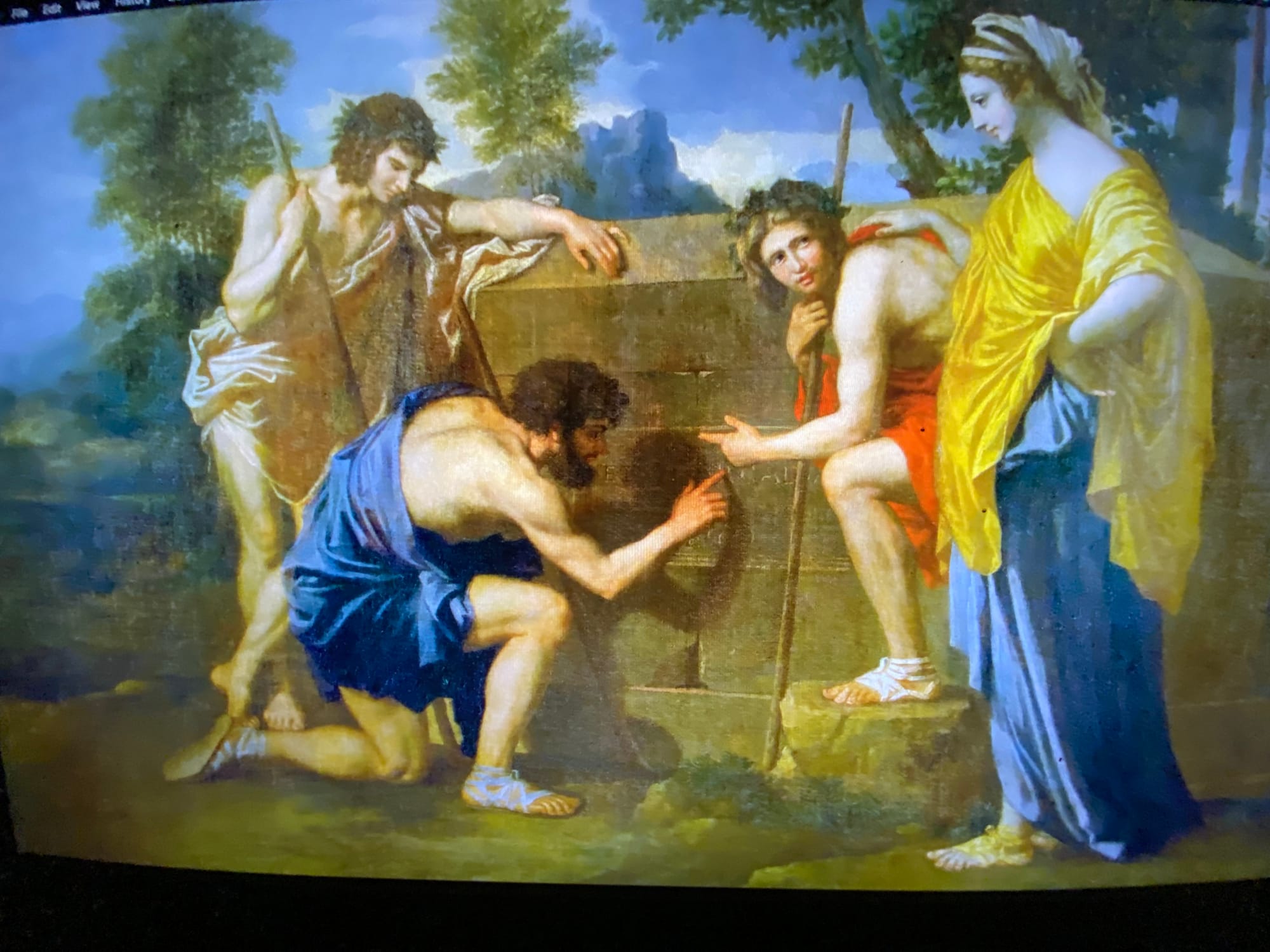
by MARCO MACULOTTI Posted 8/3/21
Originally from - https://axismundi.
blog/en/2021/03/18/et-in-arcadia-ego-the-secret-mission-of-the-other-europe-i/
_______________________________________________________________________________________
di Michael Allegri - originally released in episodes on FreeReporter.
Cover: Guercino, “Et In Arcadia Ego”, 1618.
Part 1 of 2.
_______________________________________________________________________________________
There is an ancient one nobility of the Languedoc which for centuries has pursued a political-esoteric mission inspired by the Arcadian myth of the Golden Age, the kingdom of Saturn: to create an Oasis of Peace in Europe, overcoming the hated diarchy of throne and altar. The proofs of this mission are found scattered throughout the history of Europe since the foundation of the Merovingian monarchy up to the Second World War, and are found in all the main socio-political and religious events that this article will touch. A certain Enlightenment pragmatism wants history to be read through the Latin question Whose prodest? (Who benefits?), A question that presupposes that at the basis of historical events there are always and only concrete factors, such as economic interests and the extent of the political power of a person, a group or a nation. Too often historians refuse to give due weight to a third factor, which has also proved to be a powerful motivator of human, even political, action: esotericism.
In this case, it will be seen how some ancient noble families have stubbornly carried out over the centuries a political mission based on magical-esoteric beliefs, lavishing enormous resources on it, exposing themselves to enormous personal risks and suffering heavy political and military defeats that nevertheless never posed an end to the original intent of restoring an order of peace and justice in which men would return to live, as Hesiod describes in The works and the days, “Without pain, without toil, without pain”, under the guidance of a good king. The protagonist of this mission is a part of the oldest nobility in Europe, to which some families from Languedoc (southern France, near the Pyrenees mountains) belonged, dedicated to occultist practices, which were distinguished by a specific characteristic: the descent from a semi-divine or monstrous mythological ancestor. History hands them over to us as noble descendants of the Merovingian family.
Meroveo, the first king of the Franksin fact, according to mythology, he descended, on his father's side, from one sea beast, a kind of sea dragon, called Quinotaur (beast Neptuni Quinotauri similis), from which he had inherited a magical-thaumaturgical power, as well as a physical deformity similar to a tail near the coccyx, a mark that distinguished him from other kings. Meroveo and his descendants did not like war, they were called for this reason "the idle kings". They were also defined "king charmers"As they devoted themselves to magic, art, sciences and in particular astronomy, astrology and divination, which in ancient times had rather blurred boundaries between them. Their blood, like that of the mythological dragon of the peoples of Northern Europe, according to popular traditions, had healing powers and, for this reason, they were much loved by their subjects. Their headquarters was located in Stenay, the town in the Ardennes dedicated to Saturn, the god of subversion and of the agricultural-bucolic world who holds the scythe in his hand, as well as ruler of the Golden Age, then dethroned by Jupiter.
In addition to the Ardennes, the Merovingian dynasty had also extended to the Occitan area, in the Languedoc, a region that was not part of the Kingdom of France. It was an independent area, with its own language, the Langue d'Oc, with advanced political institutions, with commercial and power relations with the Spanish families of the kingdoms of Castile and León. There nobility of Occitania and del Razès in particular, was represented by the counts of Toulouse, the Gellone, the Trencavel, the Lusignano, the Blancheforts (Bertrand, in 1153, will be Grand Master of the Order of the Templars), the De Fleury, the Roquefort, the Voisins, the Hautpoul-Felinès, the De Nègre, the D'Ables, the Joyeuses, the A-Niort and the Arques. These families became related to each other and to the descendants of the Merovingian kings starting from Sigisbert IV. What characterized this noble genealogy was:
- the custody of a family secret (defined as a treasure), hidden in the territories they govern;
- the preaching of the return of the "Great Monarch" (whose coming from Languedoc is prophesied by Nostradamus, a protege of the Lorraine house);
- a doctrinal and political rebellion against the Roman papacy, the emperors and absolute monarchs;
- the constant conspiracy to build a Europe of peace, without conflicts, in the name of the return of the golden age and precisely of its Monarch.
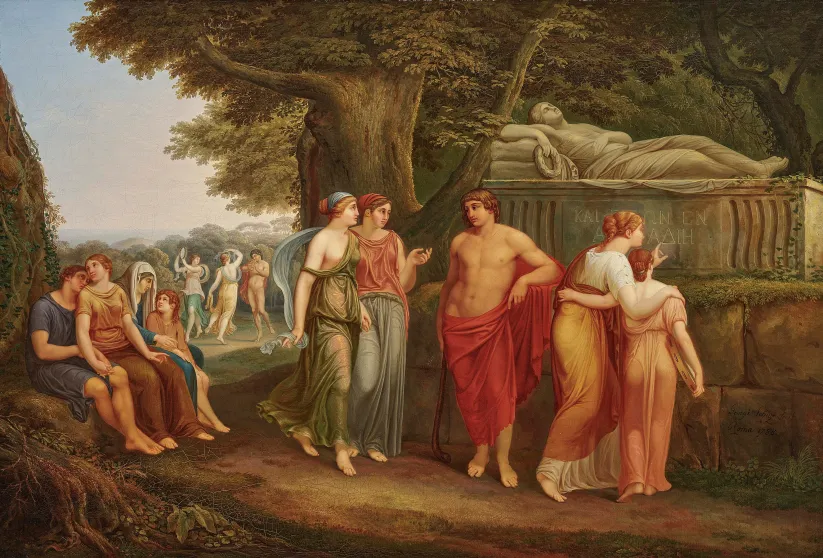 Johann Georg Schütz, “Et In Arcadia Ego”, 1788
Johann Georg Schütz, “Et In Arcadia Ego”, 1788
The noble families of Languedoc, in order to carry out this Mission, have always tried to influence the rest of the second state (the nobility, according to the eighteenth-century denomination), by crossing their coat of arms and their blood with those of as many noble European families such as the Lorraine , the Habsburgs, the Bouillon, the Gonzaga, the Sforza, the Anjou, the Guisa, the Viscounts, the Borghese, the Colonna, the Gonzaga, the Sinclair / De Saint Clair, the Savoy and the Setton to name the most important. To give an example: Guillem de Gellone was count of Toulouse and the Pyrenees and his power also extended to northeastern Spain. Protagonist of the poem Willehalm, by Wolfran Von Escehnbach, was the grandson of the Merovingian king Sigisbert IV. Guillem's son, on the other hand, was Eustachio, count of Bouillon, whose nephews are the famous nobles involved in the crusades of the year 22, Godfrey, defender of the Holy Sepulcher, and Baldwin I, king of Jerusalem. A journalist, Lionel Burrus, exponent of the Swiss Christian Youth, wrote in the "Geneva Catholic Weekly" on 1966 October XNUMX:
The descendants of the Merovingians have always been the inspirers of all heresies, from Arianism to the Cathars and Templars, up to Freemasonry. The family in question, over the centuries, has generated only hostile and devious agitators to the Catholic Church.
To support these words there was also the writer S. Roux, who expounded in a pamphlet his thesis according to which;
It cannot be said that the Catholic Church ignores this lineage but it must be remembered that all its descendants, starting with the Merovingian king Dagobert II, were secret agitators, hostile both to the French ruling house and to the Church and that they were the source of all the European heresies ...
This dynasty, in fact, acquired power and consolidated its family traditions in the Middle Ages, during which troubadours, minesinger and poets made them protagonists of the vast and fascinating literature of the Grail and the Breton Cycle, works in which the pagan-magical background of these families (the famous family of the Grail of the Languedoc that bears a "mark" that distinguishes them) is still very evident. A tangible example of the hostility to the diarchy of the two Suns is found precisely in the foundation of theOrder of the Templars, promoted in 1118 by the noble Hugues des Payns of Champagne-Ardenne, married to the noblewoman Catherine St. Clair and other vassals who, taking advantage of the crusades for the reconquest of the Holy Land, planned the ambitious attempt to build a rich and peaceful kingdom in Jerusalem, an alternative to the European empire and papacy and led by Baldwin I Buglione, their protector, and then, over time, Guido di Lusignano, lord of Stenay, descendant of the snake-lady Meleusina.
It is said, in fact, that Melusine was a woman of extraordinary beauty but who turned into a snake on Saturdays. The beautiful lady, according to the chronicles of the time, was devoted to practices of black magic and, looking out from the tower of the castle of Stenay, she communicated with the wolves howling like them. Even the noble family of the Languedoc of the Hautpoul-Felines, related to the Lusignano, shared with them the lineage of the lady Melusina and local legends attribute to them the fame of werewolves, experts in black magic, worshipers of black cats. Their subjects called them "the rulers of the black mountain". Even today, every year their castle is the destination of public visits by esotericists and scholars of all kinds who hope to see the Melusina appear, in certain particular nights of black moon.
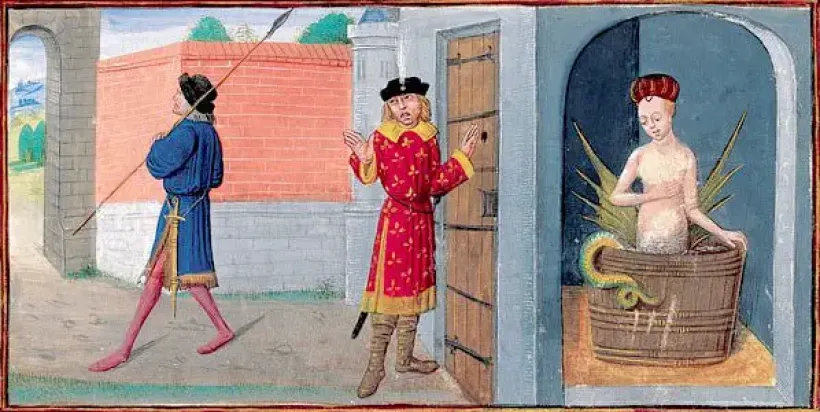 "Melusina discovery"
"Melusina discovery"
The rivalry between the Templars (who had a third of their possessions in Languedoc), the French monarchy of Philip IV the Fair and the papacy was resolved only in 1307, with the arrest of the nobles at the top of the Templar Order, with the perpetual suppression of the Order by Pope Clement V, with the condemnation to the stake for all of them as unrepentant heretics, due to the accusations of idolatry, apostasy, necromancy, sodomy and contempt of Christ made by the Dominican Imbert and the jurist De Nogaret and confessed by the leaders of the Order. In reality, as the documents of the Carcassonne and Florence trials tell us, the Templar doctrine was based on a strong Manichaean dualism. These warrior-monks prayed as much to the "God Who Is in Heaven" as to a terrifying-looking bearded idol called "the true Savior" also called "Baphomett" or "MagumetWhich allowed them to have wealth and power. Jesus, for the Templars, was a minor figure. He was often referred to as a "thief, crucified for his sins". In the initiation practices, neophytes were ordered to spit on the cross and then trample it with the formula "do not believe in him, he cannot save you".
Also in medieval times, these noble families took sides in political and military defense of the gods cathars, the Manichean-dualist heretical movement that from the year one thousand until 1210 had taken root in the Languedoc and in a vast area that went from Liguria, passing through Lombardy, Austria, Germany up to the Balkans. Catharism was a complex doctrine that saw the opposition of two principles (good vs evil) and two divinities, the father who is in heaven and the demiurge, creator of the world and of all visible things. The majority of "good men" or "perfect", as the Cathars were defined, preached and practiced peace, vegetarianism, poverty, equality between men and women, leading a harsh moral and doctrinal criticism of the Roman Catholic Church, considered corrupt. The epicenter of the heresy, according to Bernard of Clairvaux, was the city of Lavaur.A minority, however, more tied to the doctrine of Bogomils Yugoslavs, Bulgarians and those of Thrace, she was dedicated to strange rites in the caves of Sabhartes and believed in the existence of a "King of the world", To use an expression of the esoteric writer René Guénon, a Demiurge who dwells in the bowels of the Earth waiting to return to the surface to command. The echo of this agitated minority provoked in Carcassonne, by the Holy Inquisition, the first trial ever against a meeting of witches, in 1330. This sensist and materialistic movement also spread to Austria, Styria, Bohemia, Brandenburg and the Rhine. from 1176. In the dioceses of Passavia, Vienna and Styria they were clearly confused with the other Cathars. In 1315 about a hundred of them were burned in Krems and Saint-Hipollyte, in Bohemia.
Again, the Merovingian lineage that ruled the Languedoc paid a very high price for opposing Pope Innocent III, promoter of Crusade against the Albigensians which took place between July and August 1209, attended by noble families loyal to the pope but not the Templars, who refused to go to fight in solidarity with the Cathars. Simon De Monfort and the Catholic nobility did not hesitate a exterminate the Cathar population gathered in the fortress of Montsegur and to kill or arrest some members of the Occitan nobility who had supported them, such as members of the Trencavel family or the count of Toulouse, Raymond VI. Incidentally, the Count of Toulouse had high-ranking relatives even outside the Languedoc. He was the son of Queen Constance, sister of the King of France Louis VII, and his wife was the sister of the King of England and had formed alliances with the German Baron Otto de Brunswick. These blood ties allowed that, after the defeat, the noble families of the Languedoc could continue to oppose the papacy and the Roman curia, first supporting the Avignonese Pope John XXII, former bishop of Alet Les Bains, in the Occitan-Cathar territory, and then Cardinal Baldassarre Cossa, of the Angevin family and lord of Ischia who will be the antipope Giovanni XXIII, whose name, strangely, was readopted in 1958 by the noble cardinal Angelo Roncalli, the "Good Pope" who, according to many, inside and outside the Leonine walls, it belonged to the Rosicrucian movement.
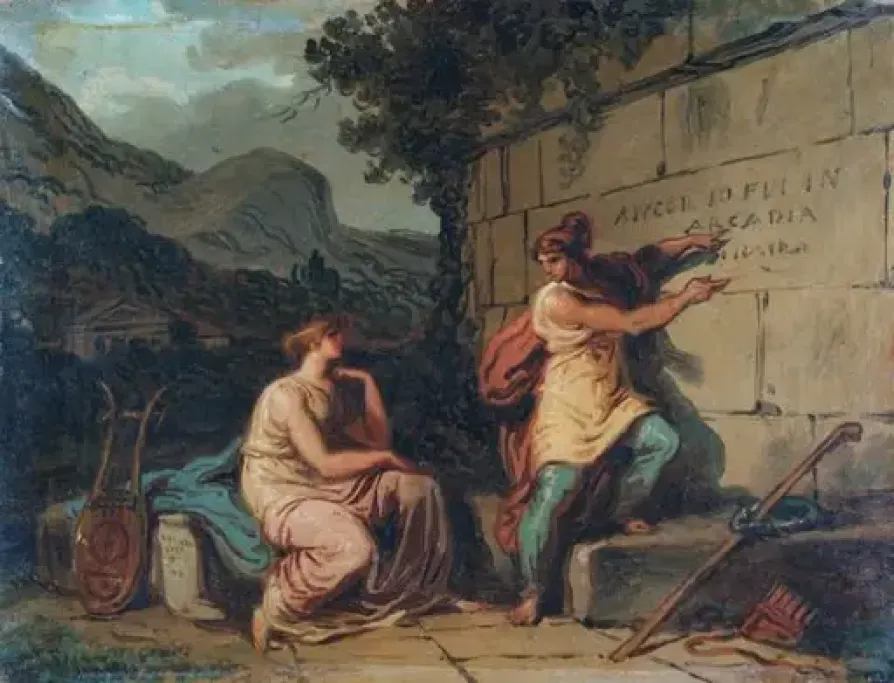 Felice Giani, “Et In Arcadia Ego”, circa 1800
Felice Giani, “Et In Arcadia Ego”, circa 1800
This Belgian-Occitan nobility, heretical and dedicated to magical practices, after the suppression of the Templar Order and the defeat of the Cathars, changes strategy and constitutes a dark and powerful secret society. It is born the fog. Its outer circle is there Angelic Society. It is in this period that in Europe we are witnessing a persecutory ferment against heretics and more generally against the pagan religion, branded as witchcraft, which will strike priests and friars such as Urbano Grandier but above all women, even belonging to the nobility, such as Guglielma di Clairvaux (daughter of the Bohemian king Ottokar I and considered by her followers to be the female messiah), the baroness Jeanne des Anges, the marquise Anne de Sainte Agnes and even Claire de Saint Jean, nephew of Cardinal de Richelieu. An emblematic case was that of Leonora Galilai, wife of Concino Concini, in turn the grandson of some ministers of the Grand Duke of Tuscany. She was the companion of Queen Maria de Medici, she was accused of practicing the witchcraft. After searching his house, some books with magical symbols, rolls of red velvet, some charms and talismans were found. She was found guilty, beheaded, and her remaining body was burned in 1617. As with the Templars, she moved the car of the Holy Inquisition with the Index of Forbidden Books: everyone, including nobles, could be accused of witchcraft and heresy which, at that time, were synonymous.
The "witch hunt"Then led this nobility, at the end of the 1400s, to move quietly and to establish a secret society called Brouillard ("Fog"). It is no coincidence that the French pronunciation of the name of this sect is identical to the word bruja which, in Occitan and Castilian, means precisely "witch". The name "Nebbia" wanted to remember something ethereal, impalpable, difficult to grasp and therefore to hit, but also something mythological: the haze that covers the kingdom of Thule or the Greek Olympus or, better still, the cloud that surrounds the kingdom of Saturn. Once again, the headquarters of the Mist will be in the town of Stenay, in the Ardennes. An external circle was built around this organization, open to painters, writers, musicians, poets and scholars who wanted to manifest their conceptual rebellion against the obscurantist alliance of throne and altar, rediscover ancient European pagan traditions and give impetus to the development of the sciences. new and old. This outer circle was therefore in charge of propaganda through art, disseminating coded messages that had to escape the apparatus of the Holy Inquisition but which, symbolically, had to break through the changing society, "uniting people who would have had no reason to know each other".
The period, in fact, was characterized by Humanism and then by the Renaissance. Figures like Pico della Mirandola, Leonardo da Vinci, Giordano Bruno they moved on the verge of heresy. Bruno in particular, philosopher and monk, re-evaluated hermeticism, natural magic, studied the planets talking about pantheism, becoming a good advisor to monarchs for peace in Europe and for the development of diplomacy between kingdoms, but will later be burned as a heretic from the Venetian Holy Inquisition. There will also be one rediscovery of Platonic thought, the myth of Atlantis and the first humanity that lived in peace and was technologically advanced (we remember The New Atlantis of Bacon). Knowledge and not blind faith in the Bible or Aristotelian thought became the focus of the interests of thinkers and artists. The outer circle was called the Angelic Society, in memory of the rebel angels who, as the Bible tells us, taught the daughters of men magical practices and who are the messengers of this Mist, mediators between men and supernatural forces.
 Shugborough Relief
Shugborough Relief
The German typographer from Reitlingen in Wurttemburg, Sebastian Greif (called Gryphe, i.e. Griffin) was the activator in 1522 and spread the Angelic Society in Germany and France, under the careful guidance of Raymond de Saint Gilles, the Count of Toulouse , a big shot of the Languedoc nobility. The mysteriosophy of this group is very complex: the paranoid passion for the Secret, the veneration of a sacred tomb, magical practices for the resurrection of bodies, the exaltation of the myth of Greek Arcadia and the golden age (the Saturnia Reigns), the desire to subvert the status quo which manifests itself with the inversion of sacred images, phrases or letters. It's still: the myth of eternal youth, of the Grail, the magical doors that lead to the underworld, in the realm of the dead, the Hades of the Greeks which was accessed from the region of Arcadia, but also in the first Kingdom of Peace, Atlantis, where the first royal deity ruled over the first immortal humanity. Symbol of the group was a marine octopus, formerly associated with the Demiurge or king of the world.
The motto, on the other hand, a cryptic Latin phrase, Et In Arcadia Ego ..., on the meaning of which scholars from all over the world are still wondering. This enigmatic phrase will appear in a famous painting by Giovanni Francesco Barberi, known as Guercino, in 1618, in which two shepherds enter a clearing and come across a tomb bearing this inscription, and in one, more famous, of Nicolas Poussins, The Shepherds of Arcadia, in which three shepherds, within a bucolic context and under the watchful gaze of an initiatory female guide, discover a tomb bearing this strange inscription. Poussins will turn out to be the protégé of Sublet de Noyers, first steward of the house of the Joyeus, nobles of Languedoc. On April 7, 1647, he wrote a rather ambiguous letter to a painter friend about a Secret:
I could tell you things on this subject, which are very true but unknown to everyone. We must therefore pass them over in silence.
Also on the external grounds of the residence of the Counts of Lichfield of Shugbourgh Hall, in Staffordshire, a large bas-relief with the famous painting by Poussins and the inevitable Latin writing is still visible. This house then passed into the hands of the noble Anson family, which had among its descendants the famous admiral who circumnavigated the globe. On his death in 1762, this elegy, full of coded messages, will be read in the English parliament:
The eye rests on that stained marble.
The scene tears a moral sigh.
Even in the Elysian plains of Arcadia,
among the laughing nymphs and shepherds,
see the festive joy dying out,
and pity substitute the smile;
where the dances, the lute, the parties
The passion that vibrates in burning hearts,
In the youthful flower of life,
The reason stands and points to the Tomb.
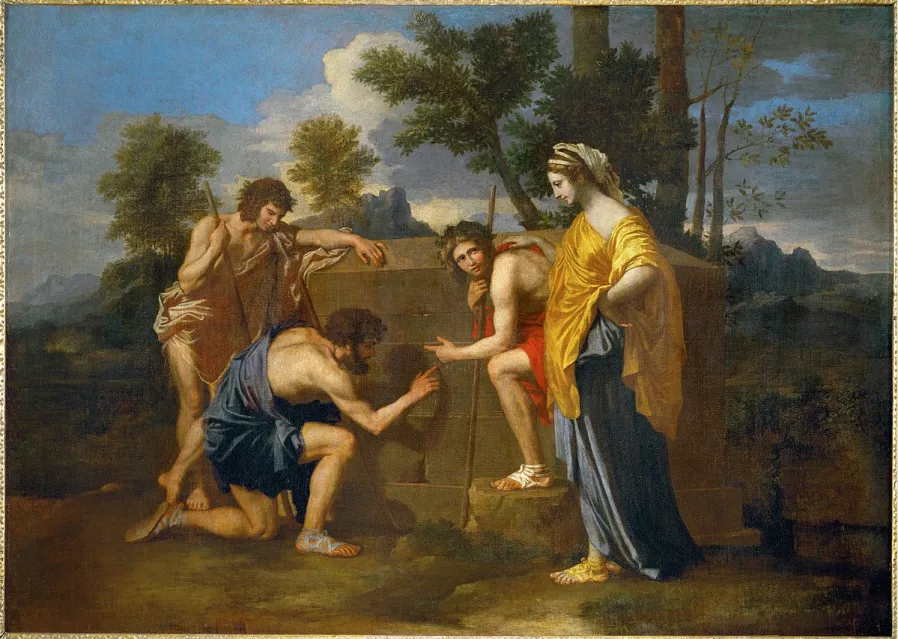 Nicolas Poussin, “Shepherds of Arcadia”, around 1640
Nicolas Poussin, “Shepherds of Arcadia”, around 1640
The key work of the Angelic Society was the Dream of Polifilo, written in 1467 by the Dominican monk Francesco Colonna, lord of Palestrina and close collaborator of Pope Borgia. The protagonist of the Work is Polia who, after having abjured Christianity considered a false doctrine, is carried by the dragon into the underworld to make an initiatory journey that culminates in the presence of the goddess Venus, from which he receives the new light of knowledge. In the coats of arms of some of these noble families, the dragon or snake, as in the case of the Borghese and Visconti. The dragon was then the emblem of the Ghibelline party, that secular faction that opposes the Guelph party, linked to the Church of Rome.
And it is in this period that the noble villas are filled with statues of Arcadian, rural and mythological significance. Dragons and snakes but also nymphs, Greek gods like Venus and demigods like Bread they replace Christian saints and Old Testament images. All the nobility, landowners, rediscover the rural and bucolic world by re-reading Virgil's passages. They consider themselves Good Shepherds who must guide their subjects, they become patrons of artists who must glorify the arts and sciences with their commitment. For many centuries, the myth will be recurrent among artists. Think for example of the The Magic Flute (di Pan) by the Austrian and Freemason WA Mozart in the Enlightenment era, an artist much appreciated at the court of Austrian nobles and cardinals.
Interesting, in the mid-1400s, is the figure of Renato d'Angiò, count of Piedmont, Lorraine and Jerusalem, as well as mistress of Giovanna D'Arco (she too fell into the Inquisition as a heretic and for this reason burned at the stake), known as the Good René, the good king-shepherd of the rediscovery of Arcadia. A man of court and not of war, dedicated to magic, he hosted Jean de Saint Remy, a cabalist doctor and grandfather of Nostradamus, for many years. He influenced the Medici in Florence and went to live in Tarascona, a famous city built in honor of the mythological dragon called Tarasca. In his work dedicated to Arcadia, he speaks of a tomb near an underground river. The Neapolitan Jacopo Sannazzaro will also come across this theme in the work Arcadia in 1504. The trend was so fortunate, involving personalities in every field of knowledge, that an Academy of Arcadia was established in 1690, whose members would define themselves Shepherds while the sign will be unequivocal: a god Pan playing the seven-horned syringe. The seat, donated by King John V of Portugal, will see Pope Leo XIII as an active member of the Arcadian sessions. It is no coincidence that the Angelica Library will be connected to it in Rome. The writer Maurice Barrès in his "Inspired Hill" of 1913 will write about it:
Et In Arcadia Ego,
I too have been in Arcadia,
in the wonderful land of the imagination,
a genius shouts to us from the tomb ...
Under the impulse of these cultural manifestations, the fifteenth and sixteenth centuries were terrible years for Christian Europe and the unity of the Catholic faith under the banner of the apostolic and Roman pontificate. This agitating and subversive nobility supported the Anglican schism in England, the Huguenot movement in France, that of the Calvinist churches in Switzerland, and the Protestant Reformation in Germany. Luther is, in fact, well protected by the nobility that opposes both the pope and the emperor Maximilian I, starting with Prince Frederick III of Saxony. Other peers of him such as George of Brandenburg, Ernest of Brunswick and Philip of Hesse will shield and square before the theologian of Saxony when he will be declared a heretic by Pope Leo X. The German princes will then form the League of Smalcalda, carrying on their war that will culminate in the Peace of Augusta of 1555, which gave the possibility to every German prince to embrace the Lutheran reform, binding his own subjects. Meanwhile, in Scotland, the noble Sinclair family, belonging to the dissolved Templar Order, manifesting their hostility to the papacy, instituted a form of speculative Freemasonry, revitalizing the ancient medieval masonry guilds and building the Rosslyn Chapel in which, next to the Templar crosses, the Masonic compasses and symbols of a magical-pagan nature appear.
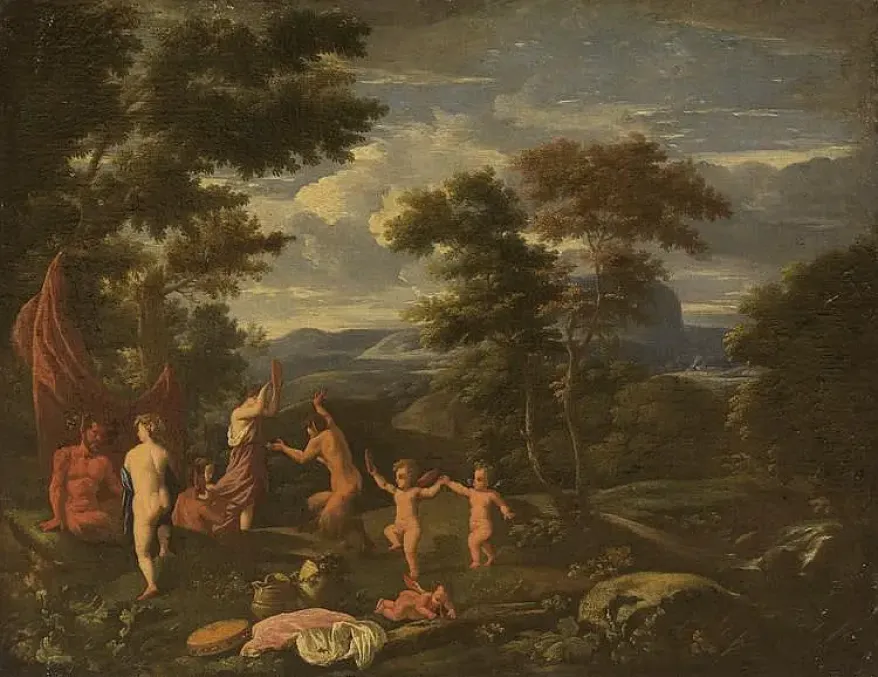 Filippo Lauri, “Landscape with dancing fauns and nymphs”, XNUMXth century
Filippo Lauri, “Landscape with dancing fauns and nymphs”, XNUMXth century
End of part 1 of 2